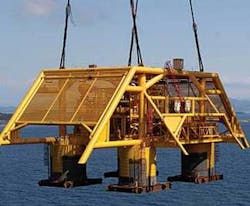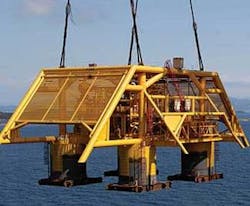DRILLING & PRODUCTION
Frank Hartley , Houston
First real-time HP/HT camera
EV Offshore Ltd. has developed the EVOLeye HPHT 200 camera inspection system. It is the first of its kind to capture images in real time downhole under high pressure and high temperature conditions.
The company says that following an intensive period of testing and development, the quality of the video transmission is the highest available. Several companies have contributed R&D funding to expedite development of the new HP/HT system in hopes of speeding its delivery to the market. Currently, the EVOLeye HPHT 200 is scheduled to be fully operational in 1Q 2008
Additionally, the company recently developed an acoustic module following the initial launch of the EVOLeye HPHT 200. This module can produce imaging in zero visibility and is designed using the same telemetry as the video module.
Sand control screen solutions
Halliburton has developed three new screen solutions for sand control. These are the EquiFlow Oil Selector valve, which is capable of reducing unwanted water or gas production without wellbore intervention; EquiFlow inflow control device, which delays early water or gas coning to increase recoverable reserves; and PetroGuard Advanced Mesh screen, which provides reliable sand control in heavy oil and poorly sorted sand environments.
“The industry is caught between the engineering challenges of increasingly complex completions and the need to reduce overall completion costs to improve well economics,” says David King, senior vice president of Halliburton’s Completion and Production Division. “The company has analyzed the challenges posed by water or gas breakthrough in order to simplify sand control completions while increasing reliability.”
Wells are often drilled in formations prone to unwanted water or gas production, which displaces the flow of hydrocarbons. In conventionally completed wells, water or gas breakthrough is addressed through remedial treatments. The oil selector valve helps prevent unwanted water or gas from entering the production string. This enables operators to avoid down time and reduces operational costs associated with remediation, and the handling and disposing of produced water.
Horizontal completions increase contact with the reservoir to help optimize production, but add the risk of water or gas breakthrough, which ultimately may result in having to abandon the well. The inflow control device helps optimize reservoir contact with horizontal wells by delaying water or gas breakthrough to increase productivity and ultimate reservoir recovery.
This mesh screen technology resists plugging by heavy oil and also by variable quality pay sands that otherwise would require the expense of more complex gravel pack installation. Unlike conventional oilfield screens that can plug rapidly, the construction of this screen increases the application range of screen-only completions to reduce overall completion costs.
Tordis subsea facility installed
Statoil’s Tordis subsea facility is on the seabed near Gullfaks field in the North Sea. The SaipemS7000 crane vessel lowered the 1,250-ton (1,134-metric ton) structure onto the Tordis field and completed the operation the following day.
The marine operations in the field will continue over the next few months. The seabed separator now will be tied back to the Statoil-operated Gullfaks C platform with pipelines and control cables.
This separator allows the recovery of an extra 35 MMbbl of oil from the field. Water and sand will be removed from the oil wells and pumped back into the Utsira formation at Gullfaks. This all takes place on the seabed, without an energy-intensive detour via a surface platform.
The Tordis field is 11 km (7 mi) northwest of Gullfaks C and came on stream in 1994. Oil from the field is transported by pipeline to Gullfaks C for processing, storage, and export.
Environmentally compliant drilling fluid
Baker Hughes Drilling Fluids has developed the Terra-Max system, a customizable, high-performance water-based mud designed for improved drilling and environmental performance in a low salinity environment. The company says that by combining state-of-the-art drilling fluid technologies, the system produces total inhibition of formations encountered on inland water and onshore drilling applications.
The system is designed to meet specific drilling objectives versus conventional water base muds. As a water-based fluid, the system presents fewer associated environmental liability issues, reduced waste management problems, and minimal lost circulation impact.
According to the company, field performance tests indicate the system provides better drilling performance compared to earlier water-based mud systems and has delivered economic value to drilling parameters such as wellbore stability, clay inhibition, enhanced rates of penetration, reduced torque and drag, reduced environmental impact, dilution rates, disposal costs, and rig time savings.
ONGC uses rotary steerable
The use of a rotary steerable system for extended reach drilling (ERD) in ONGC’s Mumbai High has enabled the Indian E&P major to drill successfully. The rotary steerable system was introduced to ONGC in 2003 and has made drilling operations faster and easier. The reach of ERD wells have been increased to more than 3 km (1.9 mi) and the lower layer horizontals in the L-III reservoir of Mumbai High have been made possible. There has been reduced drilling time, increased penetration rates, and reduced complications as a result. Progressive increases in the length of 12 1⁄4-in. (32-cm) diameter sections have achieved longer departures. The rotary steerable system has increased the departure limit of ERD wells and the total well length also increased. The adoption of an 8 1⁄2-in. (21.6-cm) RSS has opened the possibility of increasing ERD.
Improving reservoir characterization
Schlumberger has developed a new downhole fluid analysis (DFA) tool that promises to increased accuracy in its measurements of hydrocarbon composition, gas/oil ratio, carbon dioxide (CO2), formation water pH, and mud filtrate contamination.
A sensor within the DFA tool provides direct measurement ofin-situ fluid density in the open hole at reservoir conditions. The system also measures in-situ pH, an improvement on measurements of samples brought to the surface. The density sensor is combined with optical spectrometers as well as fluid resistivity, pressure, temperature, and fluorescence measurements. All are used to determine the nature of reservoir fluid. This combination of measurements expands the range of compositional information, adding CO2 and ethane to the available measurements of methane, propane through pentane, hexane, and heavier hydrocarbons.
The tool includes a grating spectrometer in combination with a filter-array. The company says that when combined with improved compositional algorithms, the spectrometers render quantitative reservoir fluid analyses. This accuracy makes it possible to compare fluid properties between wells and to extend the application of DFA from a single well to multiple wells for field-wide fluid characterizations.

